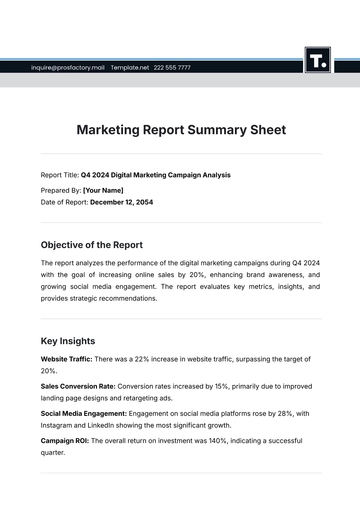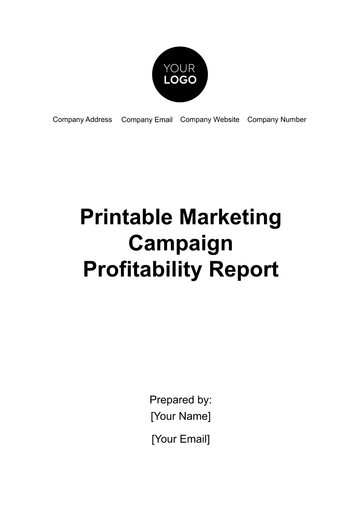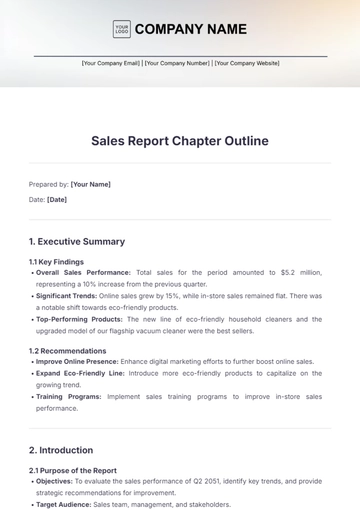Free Marketing Research Report

Prepared By | Company | Date |
|---|---|---|
[YOUR NAME] | [YOUR COMPANY NAME] | [DATE] |
I. Executive Summary
This report delves into the consumer behavior dynamics within the pet food industry. It examines trends, preferences, and purchasing habits among pet owners, providing insights for pet food manufacturers and marketers to better understand their target audience and tailor their strategies accordingly.
II. Introduction
The pet food industry is experiencing significant growth, driven by factors such as the humanization of pets, increased awareness of pet nutrition, and the rising number of pet owners. Understanding consumer behavior in this industry is crucial for businesses to develop products and marketing campaigns that resonate with their target market.
III. Research Objectives
Explore the factors influencing pet owners' purchasing decisions in the pet food market.
Identify trends and preferences among different demographic segments of pet owners.
Evaluate the impact of marketing strategies and messaging on consumer behavior within the industry.
IV. Methodology
Research Method | Description |
|---|---|
Surveys | Online surveys were conducted among a representative sample of pet owners. The surveys collected quantitative data on purchasing behaviors, preferences, and attitudes toward pet food. |
Focus Groups | Focus group discussions were organized to delve deeper into consumer motivations, perceptions, and emotional connections to pet food brands. |
Data Analysis | Survey responses and focus group transcripts were analyzed to identify patterns, trends, and key insights regarding consumer behavior within the pet food industry. |
V. Market Overview
The pet food market is experiencing steady growth, fueled by the increasing number of pet owners and their growing willingness to spend on premium pet food products. Key trends include the rise of natural and organic pet food options, grain-free formulations, and customized diets tailored to specific pet health needs.
As a result, the pet food industry is experiencing a surge in innovation, with companies continually introducing new products tailored to meet the diverse needs and preferences of pet owners. Amidst this dynamic landscape, understanding market trends and consumer behavior is imperative for pet food businesses to stay competitive and capitalize on emerging opportunities for growth.
VI. Consumer Behavior Analysis
Analysis of consumer behavior in the pet food industry shows that pet owners prioritize health and nutrition, viewing pets as family. This drives demand for nutritious, natural, and organic pet food options, influenced by trends in clean eating and wellness. Ingredient quality and formulation are key factors in purchasing decisions.
Brand reputation significantly influences consumer behavior in the pet food market, with trust in transparent and reliable brands leading to loyalty, repeat purchases, and advocacy among pet owners.
Understanding consumer behavior in the pet food industry is crucial for businesses to succeed. By acknowledging health trends, brand perceptions, and digital interactions, pet food companies can adapt their strategies to meet pet owners' changing needs, ensuring long-term success.
VII. Key Findings
Pet owners prioritize their pets' health and nutrition in pet food purchases, viewing them as family members. Ingredient quality and natural formulations drive their choices, reflecting broader trends in clean eating and wellness for pets.
Brand reputation is crucial in the pet food industry as it influences consumer behavior. Pet owners prefer trustworthy brands with transparent sourcing and manufacturing. Established brand loyalty fosters long-term consumer relationships, leading to repeat purchases and advocacy.
The research highlights the growing impact of digital marketing and social media on consumer perceptions and decisions in the pet food industry. Especially among younger demographics, digital channels are key for engaging pet owners. Using effective digital strategies like engaging content and influencer partnerships helps pet food brands build awareness, community, and loyalty in a competitive market.
VIII. Recommendations
Product Innovation: Develop innovative pet food formulations that emphasize natural ingredients, customized diets, and functional benefits.
Brand Building: Invest in building strong brand identities, emphasizing transparency, trust, and authenticity.
Digital Engagement: Enhance digital marketing efforts, including social media presence, content marketing, and influencer collaborations, to connect with pet owners and drive brand awareness and loyalty.
IX. Conclusion
Understanding consumer behavior is essential for pet food manufacturers and marketers to stay competitive in the evolving pet food market. By leveraging insights from this research, businesses can develop tailored strategies to meet the diverse needs and preferences of pet owners and drive growth in the industry.
- 100% Customizable, free editor
- Access 1 Million+ Templates, photo’s & graphics
- Download or share as a template
- Click and replace photos, graphics, text, backgrounds
- Resize, crop, AI write & more
- Access advanced editor
Analyze and present your market insights with the Marketing Research Report Template by Template.net. This customizable and downloadable template enables you to document research findings, insights, and recommendations comprehensively. Printable and editable in our AI Editor Tool, it allows you to tailor the format to suit your specific needs, ensuring your research data is communicated clearly and professionally.
You may also like
- Sales Report
- Daily Report
- Project Report
- Business Report
- Weekly Report
- Incident Report
- Annual Report
- Report Layout
- Report Design
- Progress Report
- Marketing Report
- Company Report
- Monthly Report
- Audit Report
- Status Report
- School Report
- Reports Hr
- Management Report
- Project Status Report
- Handover Report
- Health And Safety Report
- Restaurant Report
- Construction Report
- Research Report
- Evaluation Report
- Investigation Report
- Employee Report
- Advertising Report
- Weekly Status Report
- Project Management Report
- Finance Report
- Service Report
- Technical Report
- Meeting Report
- Quarterly Report
- Inspection Report
- Medical Report
- Test Report
- Summary Report
- Inventory Report
- Valuation Report
- Operations Report
- Payroll Report
- Training Report
- Job Report
- Case Report
- Performance Report
- Board Report
- Internal Audit Report
- Student Report
- Monthly Management Report
- Small Business Report
- Accident Report
- Call Center Report
- Activity Report
- IT and Software Report
- Internship Report
- Visit Report
- Product Report
- Book Report
- Property Report
- Recruitment Report
- University Report
- Event Report
- SEO Report
- Conference Report
- Narrative Report
- Nursing Home Report
- Preschool Report
- Call Report
- Customer Report
- Employee Incident Report
- Accomplishment Report
- Social Media Report
- Work From Home Report
- Security Report
- Damage Report
- Quality Report
- Internal Report
- Nurse Report
- Real Estate Report
- Hotel Report
- Equipment Report
- Credit Report
- Field Report
- Non Profit Report
- Maintenance Report
- News Report
- Survey Report
- Executive Report
- Law Firm Report
- Advertising Agency Report
- Interior Design Report
- Travel Agency Report
- Stock Report
- Salon Report
- Bug Report
- Workplace Report
- Action Report
- Investor Report
- Cleaning Services Report
- Consulting Report
- Freelancer Report
- Site Visit Report
- Trip Report
- Classroom Observation Report
- Vehicle Report
- Final Report
- Software Report





























